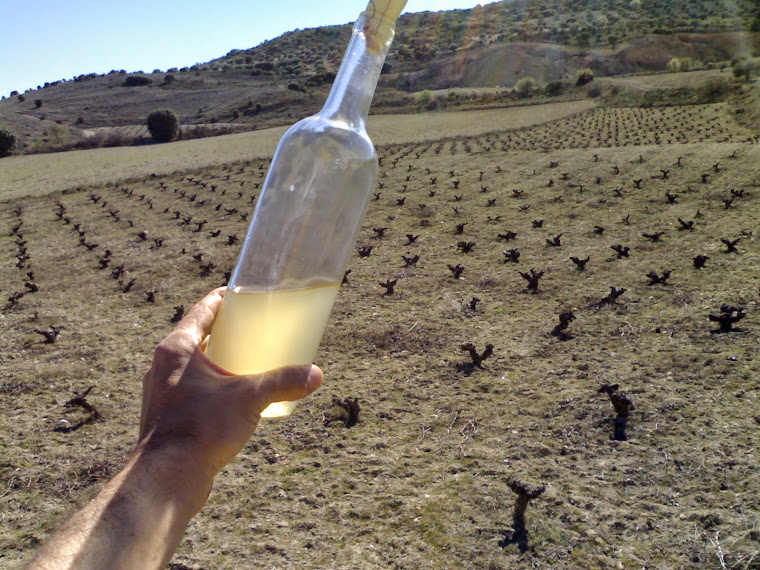1. Airén (Carbonic Maceration)
This experiment is working out very well so far. Yesterday we opened up the tank that had been hermetically sealed 17 days previously. The whole clusters had started to ferment inside each grape as expected.
Bunches of Airén at bottom of stainless steel tank
We then crushed and pressed the grapes as usual; and the must is now continuing with it's fermentation. The aromas are definitely different from those we usually get from Airén fermented 'normally'; we smelled fruit salad or ripe fruit.
This experiment is also working out well so far. We pressed the wine off the skins and the fermentation is now basically finished. I think we just need to leave it alone and not do anything at all to it over winter. Time and low temperatures will round it off (I think/hope) and we could bottle it in Jan/Feb. On the other hand, it seems perfectly drinkable to me now, but I suppose it'll improve.
The colour is rather dark for a white wine - sort of browny-ambar-orange- and the armoas are also stringer, darker, more intense than in a normal white wine.
3. Shiraz (or Shirah?)
This is only really an experiment in the sense that it's the first time we're working with this variety. We destemmed, crushed, fermented it conventionally in stainless steel. yesterday we racked it off its lees into another tank. Nothing of interest to mention here really. Again, time and low temperatures will round it off. At some point during the winter, we'll have to decide whether to oak it or not, based on our own and others tastings.
'Gunge' at the bottom of the Shiraz tank
4. Petit Verdot
Here we had a slight complication - it wouldn't start fermenting! Maybe it was due to the colder weather. Nightime temperatures have dropped quite a lot recently here in Madrid and they've been reaching under 10ºC, and daytime temperatures inside the bodegas have been around 16ºC.
So a few days ago we started taking the tank outside into the patio during the day to warm it up a bit. And we also added a liter of our Airén which was in full fermentation, so as to add in some active natural yeast.
I think it's worked, because yesterday for the first time we could see a few tiny CO2 bubbles popping. And the skins seemed to be a little higher (ie being pushed up by the COs).
Two casks of Graciano and tank of Petit Verdot
5. Graciano
I've kept this strange case for last! Again we had/have a case of fermentation not starting, but with a strange twist in the tale!!!
We decided to ferment the Graciano in oak casks because 1) we wanted to experiment with fermenting in oak casks! and 2) because we had run out of stainless steel tanks! So anyway, we duly destemmed and crushed the Graciano grapes and poured them into 3 oak casks, to about the 2/3 full level. The weird thing is that one cask started fermenting on schedule as expected, but the other two didn't! We had done everything exactly the same with all three: same grapes, destemmed and crushed at same time, casks filled at same time, etc).
There's only one difference that i can see, but can't imagine how it could possibly be the cause of this mystery: It's that the two stuck casks are from Seguin Moreau while the one that started is from Demptos!
Anyways, we've been puting the two casks out in the sun along with the Petit Verdot and we've also added a lites of Airén with active natural yeast. Still no sign of fermentation so far :(





How long was the Airen on the skins?
ReplyDeleteHi Hank,
ReplyDeleteI just checked my notes at the bodega. It was 13 days on the skins